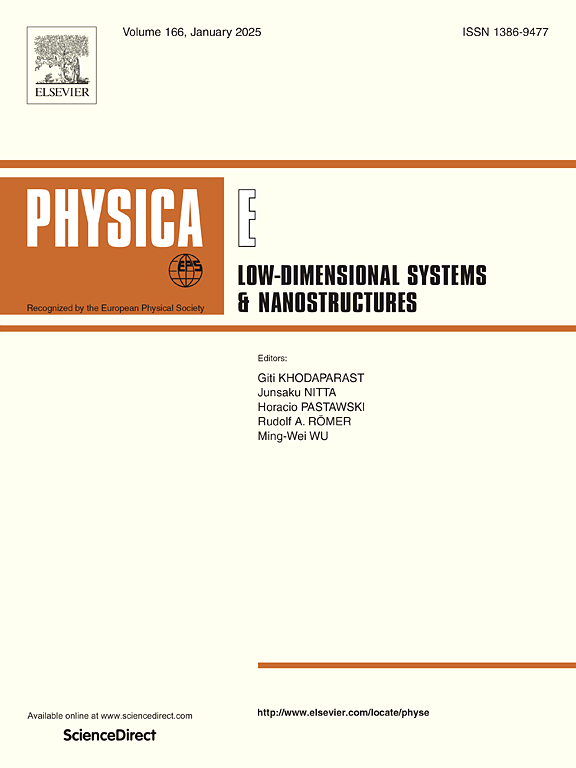Yu-Shiba-Rusinov 边界态促进表面奇频配对
IF 2.9
3区 物理与天体物理
Q3 NANOSCIENCE & NANOTECHNOLOGY
Physica E-low-dimensional Systems & Nanostructures
Pub Date : 2024-10-26
DOI:10.1016/j.physe.2024.116127
引用次数: 0
摘要
我们预测,在金属-自旋翻转器-金属-S 波超导体(N1-sf-N2-S)和超导体-金属-自旋翻转器-金属-超导体(S-N1-sf-N2-S)结这两种不同的设置中,零能级于-芝巴-鲁西诺夫(YSR)束缚态的出现会使表面奇频超导配对成倍增强。另一方面,在没有这些束缚态的情况下,偶频配对会主导表面奇频配对。具体来说,在 S-N1-sf-N2-S 约瑟夫森结中,零能 YSR 边界态的出现会导致 0π 结转变和表面奇频配对占主导地位。值得注意的是,在没有 YSR 约束态的情况下,奇频配对会消失。有趣的是,在这两种设置中,等自旋三重配对都是奇频超导的主要成分,这可能对超导自旋电子学有重要影响。总之,我们的发现可能有助于通过观测表面奇频配对来探测 YSR 约束态的存在,并有助于更好地理解它们之间的关系。本文章由计算机程序翻译,如有差异,请以英文原文为准。
Yu-Shiba-Rusinov bound states boost surface odd-frequency pairing
We predict that the appearance of zero-energy Yu-Shiba-Rusinov(YSR) bound states in two different setups, metal-spin flipper-metal-s-wave superconductor () and superconductor-metal-spin flipper-metal-superconductor () junctions, can cause a multi-fold enhancement of surface odd-frequency superconducting pairing. On the other hand, in the absence of these bound states, even-frequency pairing dominates surface odd-frequency pairing. Specifically, in the Josephson junction, the emergence of zero energy YSR bound states leads to a junction transition and surface odd-frequency pairing dominance. Notably, odd-frequency pairing vanishes in the absence of the YSR-bound states. Interestingly, the equal spin–triplet pairing is the dominant component in odd-frequency superconductivity in both setups, which could have important implications for superconducting spintronics. Overall, our findings may help to detect the presence of YSR-bound states through the observation of surface odd-frequency pairing and contribute to a better understanding of their relationship.
求助全文
通过发布文献求助,成功后即可免费获取论文全文。
去求助
来源期刊
CiteScore
7.30
自引率
6.10%
发文量
356
审稿时长
65 days
期刊介绍:
Physica E: Low-dimensional systems and nanostructures contains papers and invited review articles on the fundamental and applied aspects of physics in low-dimensional electron systems, in semiconductor heterostructures, oxide interfaces, quantum wells and superlattices, quantum wires and dots, novel quantum states of matter such as topological insulators, and Weyl semimetals.
Both theoretical and experimental contributions are invited. Topics suitable for publication in this journal include spin related phenomena, optical and transport properties, many-body effects, integer and fractional quantum Hall effects, quantum spin Hall effect, single electron effects and devices, Majorana fermions, and other novel phenomena.
Keywords:
• topological insulators/superconductors, majorana fermions, Wyel semimetals;
• quantum and neuromorphic computing/quantum information physics and devices based on low dimensional systems;
• layered superconductivity, low dimensional systems with superconducting proximity effect;
• 2D materials such as transition metal dichalcogenides;
• oxide heterostructures including ZnO, SrTiO3 etc;
• carbon nanostructures (graphene, carbon nanotubes, diamond NV center, etc.)
• quantum wells and superlattices;
• quantum Hall effect, quantum spin Hall effect, quantum anomalous Hall effect;
• optical- and phonons-related phenomena;
• magnetic-semiconductor structures;
• charge/spin-, magnon-, skyrmion-, Cooper pair- and majorana fermion- transport and tunneling;
• ultra-fast nonlinear optical phenomena;
• novel devices and applications (such as high performance sensor, solar cell, etc);
• novel growth and fabrication techniques for nanostructures

 求助内容:
求助内容: 应助结果提醒方式:
应助结果提醒方式:


